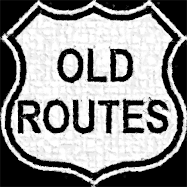In our day of hot or cold beverage holders, entertainment systems we can talk to and GPS to guide us to the nearest Starbucks with a drive thru… it is very hard to picture what is was like to take a road trip in the early 20th century.
 This picture might help. Late May 1930 R.G. Thompson had had enough of that ole Hudson Brougham. It was a pretty warm day, but he left his tie and coat on hoping the car salesman wouldn’t try to take advantage of him. He headed out from the Stock Exchange Building up 4th Avenue and uptown on Westlake to the William O McKay dealer. The Depression was tough and Eddie Pinkman was eager to make a sale. Too bad R.G. couldn’t get more in trade for the Hudson, but the sparking clean rust free Ford black paint clinched the deal. The Radiator cap added real style, too. Eddie didn’t get much commission for the sale. After all, he sold a new Ford Sport Coupe for only $679.25, but he was happy for the sale and happy to be working. As he headed back in the office, Eddie looked down Mercer Street at the closed Ford Assembly Plant wondering if it would ever open again.
This picture might help. Late May 1930 R.G. Thompson had had enough of that ole Hudson Brougham. It was a pretty warm day, but he left his tie and coat on hoping the car salesman wouldn’t try to take advantage of him. He headed out from the Stock Exchange Building up 4th Avenue and uptown on Westlake to the William O McKay dealer. The Depression was tough and Eddie Pinkman was eager to make a sale. Too bad R.G. couldn’t get more in trade for the Hudson, but the sparking clean rust free Ford black paint clinched the deal. The Radiator cap added real style, too. Eddie didn’t get much commission for the sale. After all, he sold a new Ford Sport Coupe for only $679.25, but he was happy for the sale and happy to be working. As he headed back in the office, Eddie looked down Mercer Street at the closed Ford Assembly Plant wondering if it would ever open again. Even though R.G. had to pay for the freight, oil and a tank of gas, he had a few dollars left for a couple of options.
Even though R.G. had to pay for the freight, oil and a tank of gas, he had a few dollars left for a couple of options.-Spare Tire; at least it wasn’t one of those mini spares! You can’t have a spare without covering it and locking it up. Wise decision R.G!
-Bumpers, real steel bumpers, not those fiber-plastic bumpers we use now. Bumpers were protection for the car, and helpful to push someone out of the very common mud hole.
It was only a year into the depression, so he was conservative in going for solid steel wheels rather than those fancy spoke wheels. The seemingly unending Seattle drizzle and the unpaved roads keep the wheels covered in mud anyway. The temperatures are mild enough to go without side windows as well; after all, that’s what we have coats and hats for.
R.G. enjoyed his Ford for many years, driving up and down Pacific Highway US 99. Many times work took him to Spokane on the Sunset Highway US 10. On those hot summer days he watched that shiny radiator cap carefully for overheating. The cap would too often disappear in a cloud of steam as he headed up the steep hairpin turns of Snoqualmie Pass. Thankfully, if he had real mechanical trouble, he belonged to the Automobile Club of Washington (AAA). Since 1926 they had contracts with “reputable garages” to offer emergency road service for members.
A few years later, R.G. was one of the early managers for Centennial Flour Mills, which is still a major food company, based in Seattle. Besides being a far distant cousin, R.G. hired my mother-in-law as his secretary. Seattle was a much smaller town back then.
Some of this story is true, some is daydreaming. That’s the best way to drive an Old Route, enjoying what you see and also what is written between the double yellow lines.
Copyright 2008 Dan Smith



